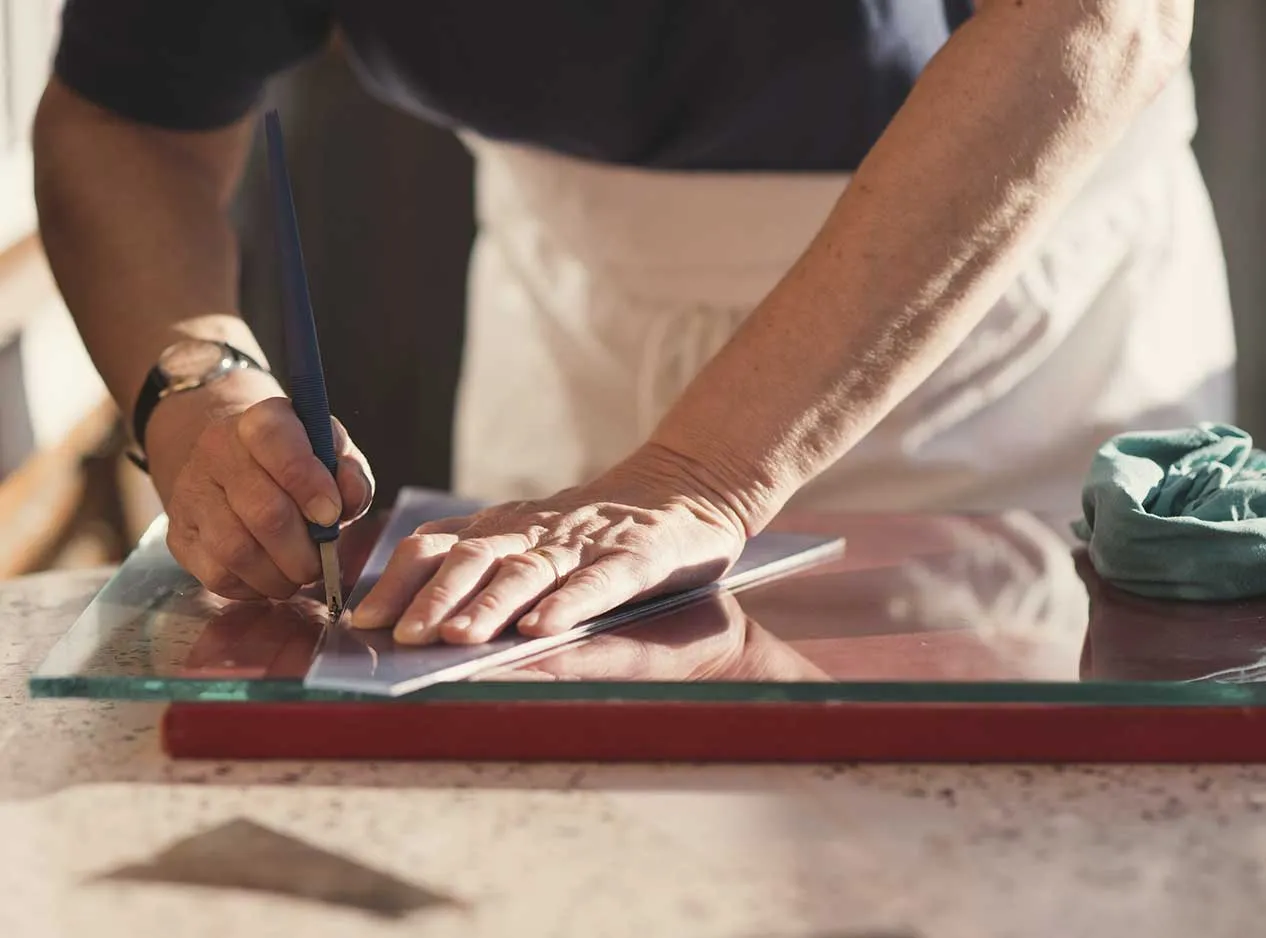Introduction
In the realm of glasswork and decorative arts, few techniques combine artistic beauty and practical function as well as cut blue glass and sandblast. These two methods are celebrated not only for their aesthetic appeal but also for their versatility in a wide range of applications, from interior décor to architectural design. The interaction of deep, vibrant hues and textured surfaces makes blue glass and sandblast an ideal choice for designers and artisans looking to create visually captivating and functional pieces.
Cut blue glass is known for its brilliant, radiant color, achieved through careful craftsmanship. Sandblasting, on the other hand, imparts intricate designs and textures to the glass, allowing for a more tactile and interactive experience. Together, these techniques represent a synergy of form, function, and creativity, making them an essential part of modern glass artistry.
In this article, we will explore the artistry and functionality of blue glass and sandblasting techniques, looking at their history, the processes involved, practical applications, challenges, and the future of these fascinating methods.
The Craft of Cut Blue Glass
Cut blue glass is a specialized art form that involves shaping glass with precision tools, such as diamond wheels, water jets, or laser cutting equipment. The aim is to produce intricate designs, clean edges, and symmetrical shapes that highlight the material’s natural transparency and color.
The Creation of Blue Glass
Blue glass is created by adding cobalt oxide to the glass mixture, giving it the rich blue hue that makes it stand out. The glass can vary from a deep, cobalt blue to a lighter azure, depending on the concentration of cobalt. The transparent nature of the glass allows light to pass through it, creating shimmering reflections and a luminous effect that adds depth and dimension to any object or design.
The Cutting Process
The cutting process itself requires significant skill and precision. Artisans use specialized tools to carefully etch patterns or shapes into the glass, ensuring that each cut is flawless. Depending on the design, the cutting process can range from simple geometric shapes to complex, ornate patterns.
The allure of cut blue glass lies not only in its striking color but also in its ability to reflect light in dynamic ways. The glass surface interacts with the light, creating a play of shadows and reflections that can transform a space or a piece of furniture into something truly extraordinary.
Sandblasting: Adding Texture and Depth
Sandblasting is a technique used to etch or frost the surface of glass, creating a textured finish. The process involves propelling fine abrasive materials (like sand) at high velocities against the glass surface. This abrasive action creates small indentations and scratches on the glass, resulting in a matte or frosted finish.
The Sandblasting Process
Artists can control the intensity of the sandblasting process, allowing for a variety of effects, from subtle, light frosting to intricate patterns. The use of stencils or freehand techniques allows for the creation of detailed designs, such as floral patterns, geometric shapes, or custom logos. The result is a piece of glass that is both visually interesting and tactile, offering a different experience when touched or viewed from various angles.
Enhancing Cut Blue Glass with Sandblasting
The combination of sandblasting with cut blue glass elevates the overall aesthetic of the piece. While the cut blue glass catches the light and reflects color, the sandblasted surface adds depth and texture, creating a visually striking contrast between smooth, reflective areas and matte, etched sections.
The Practical Benefits of Cut Blue Glass and Sandblast
While blue glass and sandblasting are known for their artistic value, they also serve numerous practical purposes. These techniques can be applied in various industries, from architecture and interior design to the production of functional items such as lighting fixtures and custom décor. Let’s explore the key applications of blue glass and sandblast:
Decorative Panels and Architectural Dividers
Cut blue glass and sandblast are frequently use in architecture to create distinctive decorative panels or dividers. These panels can be use in both commercial and residential settings, providing a unique way to partition spaces while maintaining an open, airy feel. The frosted texture achieved through sandblasting offers a level of privacy while still allowing natural light to filter through, making it perfect for office spaces, clinics, or private homes.
The vibrant blue tones of cut blue glass also bring a sense of luxury and sophistication to the design, creating a bold statement piece that stands out in any room.
Lighting Fixtures
Lighting designers often incorporate blue glass and sandblasting techniques into chandeliers, lamps, and other lighting fixtures. The refractive qualities of the cut glass allow light to be diffuse in various directions, creating interesting light patterns and enhancing the overall ambiance of a room.
When combined with sandblasting, the glass can have an added layer of texture that further diffuses light, creating a soft, diffused glow. Whether it’s a striking pendant light or a decorative lamp, blue glass and sandblast elevate the lighting design, turning functional items into pieces of art.
Custom Home Décor and Art Pieces
Cut blue glass and sandblast techniques are also widely use in the creation of custom art pieces and home décor. These techniques allow for a high level of personalization, making them ideal for bespoke designs. Whether it’s a custom glass sculpture, a hand-etched vase, or a unique piece of wall art, the versatility of these methods ensures that each creation is one of a kind.
For homeowners looking to add a personal touch to their space, custom-cut blue glass and sandblast designs provide a stunning, unique option. These pieces can reflect personal tastes, and cultural symbols, or even be create to complement the design theme of a room.
Overcoming Challenges in Cut Blue Glass and Sandblast
While the creative possibilities of cutting blue glass and sandblasting are vast, these techniques are not without their challenges. One of the primary obstacles is the fragility of glass. Both cutting and sandblasting require careful handling to avoid cracking or shattering the glass, particularly when dealing with large or intricate pieces.
The Precision Demanded in Cutting and Sandblasting
Another challenge is the precision require in both processes. For cut blue glass, achieving clean, sharp cuts without chipping or damaging the glass surface is crucial. Similarly, sandblasting demands a delicate balance to avoid over-etching or under-etching the glass. An overly aggressive sandblasting technique can result in an uneven texture, while a light hand may not achieve the desired effect.
Despite these challenges, artisans have developed ways to overcome them. Modern technology, such as computer-controlled cutting machines and advanced sandblasting equipment, allows for greater precision and consistency, minimizing the risk of mistakes and damage.
The Fusion of Traditional Techniques and Modern Technology
As technology advances, the fusion of traditional glassworking techniques with modern innovations is opening up new possibilities for artists. For instance, 3D printing has begun to influence the world of glass design, allowing for more complex and intricate forms to be create with precision. Artists can now print glass molds or use 3D printers to create glass objects directly, enhancing the level of detail and complexity possible with traditional cutting and sandblasting techniques.
The integration of these new technologies allows artisans to push the boundaries of what is possible with blue glass and sandblasting, creating more intricate, detailed designs than ever before.
Eco-Friendly Practices in Glass Artistry
In today’s environmentally conscious world, sustainability is becoming an increasingly important consideration in all forms of manufacturing, including glass artistry. The glass industry has made strides in reducing waste and incorporating recycled materials into the production process.
Sustainable Glass Production
Many artists are now crafting cut blue glass pieces from recycled glass, reducing the need for raw materials and minimizing the environmental impact of the production process. Additionally, sandblasting can be done using environmentally friendly abrasives that are less damaging to the environment. By utilizing sustainable practices, artisans can create beautiful, functional glass art without compromising the planet’s resources.
The Future of Cut Blue Glass and Sandblast Techniques
The future of blue glass and sandblasting is undoubtedly exciting. With ongoing advancements in technology and a growing emphasis on sustainability, these techniques are likely to continue evolving and gaining prominence in various fields.
Emerging Trends in Glass Artistry
The integration of digital tools, such as computer-aided design (CAD) software and 3D printing, will allow for even greater customization and precision in glass designs. Furthermore, as sustainability becomes a key priority, more eco-friendly methods and materials are expect to be adopt, ensuring that glass artistry remains both beautiful and environmentally responsible.
Conclusion
The artistry and functionality of cut blue glass and sandblast techniques represent a perfect fusion of beauty and utility. Whether used in decorative panels, lighting fixtures, or custom art pieces, these methods allow for limitless creative possibilities. With the ongoing advancements in technology and a growing focus on sustainability, the future of these techniques looks bright, promising even more intricate and innovative designs.
blue glass and sandblasting will continue to be integral to modern design, offering both aesthetic value and practical benefits. These techniques not only honor traditional craftsmanship but also embrace the possibilities of the future, ensuring that blue glass and sandblasting remain relevant and cherished in the world of art and design for years to come.
On the Run SoulTip Distributors USA Artists with Premium Tools



